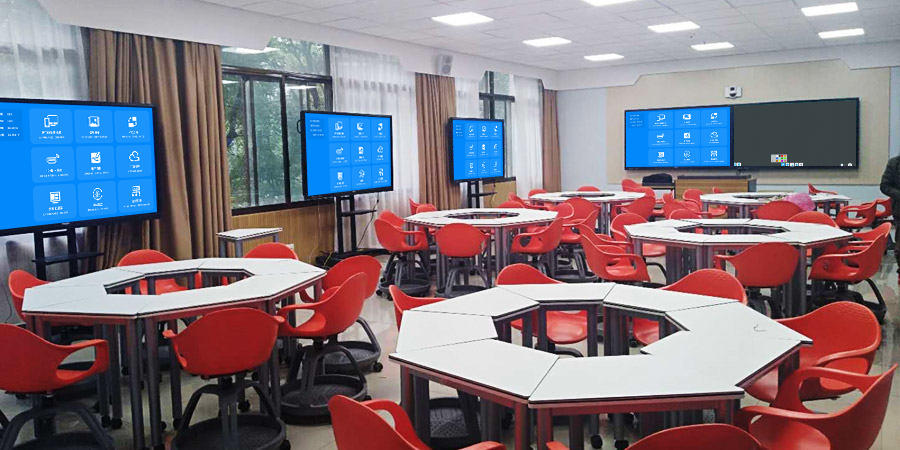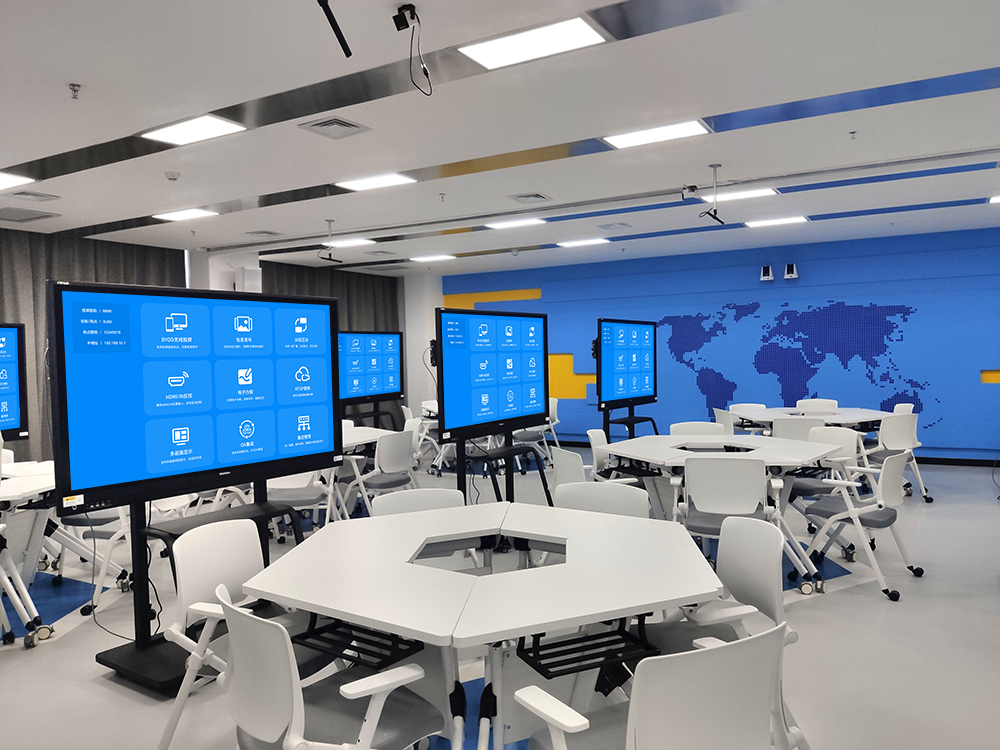Interactive Classroom: An Efficient Teaching and Collaboration Solution
The interactive classroom solution is designed to break away from the traditional one-way teaching model. Through multi-device collaboration, a variety of interactive functions, and a smart management system, it creates a fully integrated teaching, learning, and assessment environment. It’s suitable for primary and secondary schools, university labs, and vocational training, making classes more engaging and teaching more efficient.
Full Device Collaboration, Creating an Interconnected Teaching Environment
This solution is compatible with teacher devices (Windows/macOS computers, Android/iOS tablets, smart phones), student devices (tablets, laptops, clickers), and teaching terminals (electronic whiteboards, laser projectors, smart blackboards). It enables seamless collaboration across all devices:
- Fast Wireless Connection: A teacher’s computer or tablet can connect to a large teaching display in 2 seconds with a mirroring function, and student devices can join the interactive system by scanning a QR code, with no complex wiring required.
- Multi-Screen Sync: The large teaching display shows the core content, and student devices receive the courseware and exercises in sync. They can save them with one click for post-class review.
- Cross-Device Collaboration: A teacher can use a tablet to annotate and highlight content, and it will be synchronized to the large display in real time. Students can submit answers with a clicker or tablet, and the results are instantly fed back to the large display, creating a closed loop of teaching and learning.
Diverse Interactive Functions, Activating the Classroom Atmosphere
1. Precise Teaching Interaction
- Real-Time Quizzes: It supports various question types, including multiple choice, true/false, and subjective questions. Students can answer instantly on their devices, and the large display will automatically generate a data report on the answers (correctness rate, distribution of wrong answers). A teacher can then address common mistakes, avoiding a “full-class lecture.”
- Group Discussions: You can quickly divide students into study groups. Each group has its own interactive space, and the group’s work can be mirrored to a public large display for inter-group peer review and teacher feedback, which is more intuitive.
- Classroom Questions: A teacher can ask questions randomly or call on specific students. Students can raise their hand, respond with audio, or type on their devices, which encourages everyone to participate and reduces “silent zones” in the classroom.
2. Immersive Learning Experience
- Multimedia Integration: It supports synchronizing various materials like courseware, videos, animations, and 3D models to the large display and student devices. When explaining the structure of a biological cell or the principles of physics, a teacher can rotate or disassemble a 3D model to show details, which makes abstract knowledge tangible.
- Whiteboard Interaction: The large teaching display has a built-in electronic whiteboard function. It supports handwriting, drawing, erasing, and an infinite canvas. A teacher can directly annotate key points on the courseware, and students can also go up to the board and use a stylus to write, making interaction as good as with a traditional blackboard.
- Screen Mirroring Interaction: Students can mirror their homework or problem-solving processes to the large display to share them. A teacher can grade and annotate them on the spot, and other students can watch in sync, creating a “students teaching students” learning atmosphere.
3. Adaptation for Outdoor and Practical Training
- Mobile Lessons: For outdoor studies or lab training, a teacher can use their phone or tablet to take photos and mirror the live view to a mobile large display, explaining key observations in real time.
- Hands-On Sync: In a vocational training class, a teacher’s hands-on process can be mirrored to the large display with a camera, showing close-up details clearly. Students can follow the steps, and the teacher can remotely check their progress on a tablet to give timely guidance.

Smart Management and Data Analysis
More Efficient Teaching Management
- Classroom Control: A teacher can remotely control student device screens (locking, unlocking, pushing content) to prevent distractions. It also supports disabling irrelevant apps to ensure students stay focused on learning.
- Resource Management: It has a built-in teaching resource library. A teacher can quickly retrieve courseware, exercises, and case studies, and they can also upload their own resources to be organized for easy reuse.
- Attendance Tracking: When students scan a QR code to join the class, attendance is automatically recorded, and a report is generated, eliminating the need for a manual roll call and saving class time.
Data to Improve Teaching
- Learning Analytics: It automatically records students’ quiz correctness, class participation, and homework completion. It generates individual and class learning reports, which a teacher can use to adjust their teaching focus.
- Results Retention: Classroom annotations, student presentations, and interaction records can be exported as a PDF with one click to be archived as teaching files. They can also be shared with students for post-class review.
- Data Linkage: It can connect to the school’s academic system, and learning data can be synchronized to a student’s profile, providing an objective basis for teaching evaluations.
Simple Deployment and Maintenance for Any Classroom
- Flexible Deployment: It can be used for building a new smart classroom from scratch or upgrading an existing traditional classroom, with no need for large-scale demolition.
- Simple Operation: The interface is designed to match teaching habits. A teacher can get started with some simple training, and students can start using it right away by scanning a QR code.
- Remote Maintenance: An administrator can monitor the operational status of the devices in real time and can remotely turn them on and off, upgrade the firmware, and troubleshoot issues. This reduces maintenance costs and ensures class is not interrupted.
Whether for basic primary and secondary school teaching, university courses, or vocational training, this interactive classroom solution can precisely meet your needs, helping classrooms shift from “one-way teaching” to “two-way interaction” and boosting both teaching quality and learning outcomes.